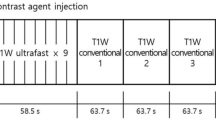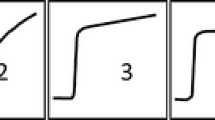Abstract
Objective
To evaluate whether the computer-aided diagnosis (CAD)–extracted kinetic heterogeneity of breast cancer on MRI and changes therein during treatment were associated with the pathological response to neoadjuvant systemic therapy (NST).
Materials and methods
Consecutive patients with invasive breast cancer, who underwent NST followed by surgery between 2014 and 2020, were retrospectively evaluated. Using a commercial CAD system, kinetic features (angiovolume, peak enhancement, delayed enhancement profiles, and kinetic heterogeneity) of breast cancer were assessed with pre- and mid-treatment MRI. Multivariate logistic regression was used to identify the associations between CAD-extracted kinetic features and pathological complete response (pCR).
Results
A total of 130 patients (mean age, 55 years) were included, 37 (28.5%) of whom achieved a pCR. When the pre- and mid-treatment MRI data were compared, the pCR group exhibited greater changes in kinetic heterogeneity (86.14 ± 32.05% vs. 8.50 ± 141.01%, p < 0.001) and angiovolume (95.20 ± 14.29% vs. 19.89 ± 320.16%; p < 0.001) than the non-pCR group. Multivariate regression analysis showed that a large change in kinetic heterogeneity (odds ratio (OR) = 1.030, p < 0.001), age (OR = 0.931, p = 0.005), progesterone receptor negativity (OR = 7.831, p = 0.001), and HER2 positivity (OR = 3.455, p = 0.017) were associated with pCR.
Conclusions
A greater change in the CAD-extracted kinetic heterogeneity of breast cancer between pre- and mid-treatment MRI was associated with a pCR in patients on NST.
Key Points
-
A greater change in kinetic heterogeneity was associated with a pathological complete response.
-
Computer-aided diagnosis–extracted kinetic heterogeneity might serve as a quantitative biomarker of therapeutic efficacy.




Similar content being viewed by others
Abbreviations
- ADC :
-
Apparent diffusion coefficient
- AUC:
-
Area under the curve
- CAD:
-
Computer-aided diagnosis
- CI:
-
Confidence interval
- DCE:
-
Dynamic contrast-enhanced
- ER:
-
Estrogen receptor
- HER2:
-
Human epidermal growth factor receptor 2
- MRI:
-
Magnetic resonance imaging
- NST:
-
Neoadjuvant systemic therapy
- OR:
-
Odds ratio
- pCR:
-
Pathological complete response
- PR:
-
Progesterone receptor
- ROC:
-
Receiver operating characteristic
References
Folkman J (2002) Role of angiogenesis in tumor growth and metastasis. Semin Oncol 29:15–18
Madu CO, Wang S, Madu CO, Lu Y (2020) Angiogenesis in breast cancer progression, diagnosis, and treatment. J Cancer 11:4474–4494
Hylton NM, Blume JD, Bernreuter WK et al (2012) Locally advanced breast cancer: MR imaging for prediction of response to neoadjuvant chemotherapy—results from ACRIN 6657/I-SPY TRIAL. Radiology 263:663–672
Reig B, Heacock L, Lewin A, Cho N, Moy L (2020) Role of MRI to assess response to neoadjuvant therapy for breast cancer. J Magn Reson Imaging 52
De Los Santos JF, Cantor A, Amos KD (2013) Magnetic resonance imaging as a predictor of pathologic response in patients treated with neoadjuvant systemic treatment for operable breast cancer. Cancer 119:1776–1783
Marinovich ML, Houssami N, Macaskill P et al (2013) Meta-analysis of magnetic resonance imaging in detecting residual breast cancer after neoadjuvant therapy. J Natl Cancer Inst 105:321–333
Gu Y, Pan S, Ren J, Yang Z, Jiang G (2017) Role of magnetic resonance imaging in detection of pathologic complete remission in breast cancer patients treated with neoadjuvant chemotherapy: a meta-analysis. Clin Breast Cancer 17:245–255
Tang S, Xiang C, Yang Q (2020) The diagnostic performance of CESM and CE-MRI in evaluating the pathological response to neoadjuvant therapy in breast cancer: a systematic review and meta-analysis. Br J Radiol 93:20200301
Ah-See MW, Makris A, Taylor NJ et al (2008) Early changes in functional dynamic magnetic resonance imaging predict for pathologic response to neoadjuvant chemotherapy in primary breast cancer. Clin Cancer Res 14:6580–6589
Partridge SC, Zhang Z, Newitt DC et al (2018) Diffusion-weighted MRI findings predict pathologic response in neoadjuvant treatment of breast cancer: the ACRIN 6698 multicenter trial. Radiology 289:618–627
Li X, Kang H, Arlinghaus LR et al (2014) Analyzing spatial heterogeneity in DCE-and DW-MRI parametric maps to optimize prediction of pathologic response to neoadjuvant chemotherapy in breast cancer. Transl Oncol 7:14–22
Furman-Haran E, Nissan N, Ricart-Selma V, Martinez-Rubio C, Degani H, Camps-Herrero J (2017) Quantitative evaluation of breast cancer response to neoadjuvant chemotherapy by diffusion tensor imaging: initial results. J Magn Reson Imaging 47:1080–1090
Cho GY, Gennaro L, Sutton EJ et al (2017) Intravoxel incoherent motion (IVIM) histogram biomarkers for prediction of neoadjuvant treatment response in breast cancer patients. Eur J Radiol Open 18:101–107
Perou CM, Sorlie T, Eisen MB et al (2000) Molecular portraits of human breast tumours. Nature 406:747–752
Cajal SRY, Sesé M, Capdevila C et al (2020) Clinical implications of intratumor heterogeneity: challenges and opportunities. J Mol Med (Berl) 98:161–177
Kim JH, Ko ES, Lim Y et al (2017) Breast cancer heterogeneity: MR imaging texture analysis and survival outcomes. Radiology 282:665–675
Wu J, Cao G, Sun X et al (2018) Intratumoral spatial heterogeneity at perfusion MR imaging predicts recurrence-free survival in locally advanced breast cancer treated with neoadjuvant chemotherapy. Radiology 288:26–35
Kim JY, Kim JJ, Hwangbo L et al (2020) Kinetic heterogeneity of breast cancer determined using computer-aided diagnosis of preoperative MRI scans: relationship to distant metastasis-free survival. Radiology 295:517–526
Parikh J, Selmi M, Charles-Edwards G et al (2014) Changes in primary breast cancer heterogeneity may augment midtreatment MR imaging assessment of response to neoadjuvant chemotherapy. Radiology 272:100–112
Fernandez G (2010) Statistical data mining using SAS applications. CRC press
Allred DC, Harvey JM, Berardo M, Clark GM (1998) Prognostic and predictive factors in breast cancer by immunohistochemical analysis. Mod Pathol 11:155–168
de Ronde JJ, Hannemann J, Halfwerk H et al (2010) Concordance of clinical and molecular breast cancer subtyping in the context of preoperative chemotherapy response. Breast Cancer Res Treat 119:119–126
Cortazar P, Zhang L, Untch M et al (2014) Pathological complete response and long-term clinical benefit in breast cancer: The CTNeoBC pooled analysis. Lancet 384:164–172
Early Breast Cancer Trialists’ Group (EBCTCG) (2018) Long-term outcomes for neoadjuvant versus adjuvant chemotherapy in early breast cancer: meta-analysis of individual patient data from ten randomised trials. Lancet Oncol 19:27–39
von Minckwitz G, Untch M, Blohmer J et al (2012) Definition and impact of pathologic complete response on prognosis after neoadjuvant chemotherapy in various intrinsic breast cancer subtypes. J Clin Oncol 30:1796–1804
Criscitiello C, Golshan M, Barry WT et al (2018) Impact of neoadjuvant chemotherapy and pathological complete response on eligibility for breast-conserving surgery in patients with early breast cancer: a meta-analysis. Eur J Cancer 97:1–6
Darland DC, D’Amore PA (1999) Blood vessel maturation: vascular development comes of age. J Clin Invest 103:157–158
Kerbel RS, Klement G, Pritchard KI, Kamen B (2002) Continuous low-dose anti angiogenic/metronomic chemotherapy: from the research laboratory into the oncology clinic. Ann Oncol 13:12–15
McDonald K, Kawaguchi T, Qi Q et al (2019) Tumor heterogeneity correlates with less immune response and worse survival in breast cancer patients. Ann Surg Oncol 26:2191–2199
Chamming’s F, Ueno Y, Ferré R et al (2018) Features from computerized texture analysis of breast cancers at pretreatment MR imaging are associated with response to neoadjuvant chemotherapy. Radiology 286:412–420
Michoux N, Van den Broeck S, Lacoste L et al (2015) Texture analysis on MR images helps predicting non-response to NAC in breast cancer. BMC Cancer 15:574
Henderson S, Purdie C, Michie C et al (2017) Interim heterogeneity changes measured using entropy texture features on T2-weighted MRI at 3.0 T are associated with pathological response to neoadjuvant chemotherapy in primary breast cancer. Eur Radiol 27:4602–4611
Choudhery S, Gomez-Cardona D, Favazza CP et al (2022) MRI radiomics for assessment of molecular subtype, pathological complete response, and residual cancer burden in breast cancer patients treated with neoadjuvant chemotherapy. Acad Radiol 29(Suppl 1):S145–S154
Eun NL, Kang D, Son EJ et al (2020) Texture analysis with 3.0-T MRI for association of response to neoadjuvant chemotherapy in breast cancer. Radiology 294:31–41
Boughey JC, McCall LM, Ballman KV et al (2014) Tumor biology correlates with rates of breast-conserving surgery and pathologic complete response after neoadjuvant chemotherapy for breast cancer: findings from the ACOSOG Z1071 (Alliance) Prospective Multicenter Clinical Trial. Ann Surg 260:608–614
Pabst T, Kenn W, Kaiser WA, Hahn D (2001) Understanding why contrast enhancement in dynamic MRI is not reproducible: illustration with a simple phantom. Breast J 7:166–170
Funding
This study was supported by an investigator-initiated research grant from Bayer Korea Ltd. The authors had complete control of the data and information submitted for publication at all times and none of the authors are or have been employed by Bayer. The results of the study only belong to the investigator.
Author information
Authors and Affiliations
Corresponding author
Ethics declarations
Guarantor
The scientific guarantor of this publication is Jin You Kim.
Conflict of interest
The authors of this manuscript declare no relationships with any companies, whose products or services may be related to the subject matter of the article.
Statistics and biometry
No complex statistical methods were necessary for this paper.
Informed consent
Written informed consent was waived by the Institutional Review Board.
Ethical approval
The study was approved by the institutional review board of Pusan National University Hospital (IRB No. 2012-018-098).
Methodology
• retrospective
• observational
• performed at one institution
Additional information
Publisher’s note
Springer Nature remains neutral with regard to jurisdictional claims in published maps and institutional affiliations.
Rights and permissions
About this article
Cite this article
Hwangbo, L., Kim, J.Y., Kim, J.J. et al. Changes in kinetic heterogeneity of breast cancer via computer-aided diagnosis on MRI predict the pathological response to neoadjuvant systemic therapy. Eur Radiol 33, 440–449 (2023). https://doi.org/10.1007/s00330-022-08998-8
Received:
Revised:
Accepted:
Published:
Issue Date:
DOI: https://doi.org/10.1007/s00330-022-08998-8




